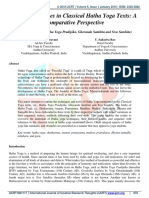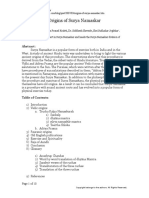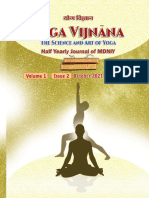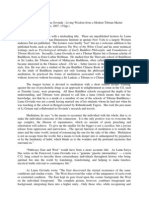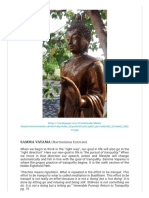What Is Yoga?: The Roots of Yoga
What Is Yoga?: The Roots of Yoga
Uploaded by
kallasanjayCopyright:
Available Formats
What Is Yoga?: The Roots of Yoga
What Is Yoga?: The Roots of Yoga
Uploaded by
kallasanjayOriginal Description:
Original Title
Copyright
Available Formats
Share this document
Did you find this document useful?
Is this content inappropriate?
Copyright:
Available Formats
What Is Yoga?: The Roots of Yoga
What Is Yoga?: The Roots of Yoga
Uploaded by
kallasanjayCopyright:
Available Formats
What is Yoga?
The Roots of Yoga
The word Yoga comes from the Sanskrit word "Yuj" meaning to yoke, join or unite. This implies joining or integrating all aspects of the individual - body with mind and mind with soul - to achieve a happy, balanced and useful life, and spiritually, uniting the individual with the supreme. In India, Yoga is considered one of the six branches of classical philosophy and is referred to throughout the Vedas - ancient Indian scriptures and amongst the oldest texts in existence.TheUpanishads are also broadly philosophical treatises which postdate the Vedas and deal with the nature of the "soul" and universe. However, the origins of yoga are believed to be much older than that, stemming from the oral traditions of Yogis, where knowledge of Yoga was handed down from Guru (spiritual teacher) to Sisya(spiritual student) all the way back to the originators of Yoga, "the Rishis," who first began investigation into the nature of reality and man's inner world. Legend has it that knowledge of Yoga was first passed by Lord Shiva to his wife Parvati and from there into the lives of men.
The Aim of Yoga
According to the Yoga Sutras of Patanjali, the ultimate aim of Yoga is to reach "Kaivalya" (emancipation or ultimate freedom). This is the experience of one's innermost being or "soul" (the Purusa). Then one becomes free of chains of cause and effect (Karma) which tie us to continual reincarnation. In Kaivalya one is said to exist in peace and tranquillity, having attained absolute knowledge of the difference between the spiritual which is timeless, unchanging and free of sorrows, and the material which is not. This is considered desirable as life is analysed as ultimately full of sorrows and pain- even pleasure and joy leave pain and loss when they have gone as nothing in the material world is permanent.
Yoga is therefore a spiritual quest. However, along the path of yoga, the aspirant also gains health, happiness, tranquillity and knowledge which are indicators of progress and an encouragement to continue their practice. Buddhism and other Eastern spiritual traditions use many techniques derived from Yoga.
The Paths of Yoga
There are said to be 4 main paths (Margas), according to the Bhagavad Gita, by which to reach the ultimate goal of Yoga - "Kaivalya." There is the path of Knowledge (Jnana Marga) in which one learns to discriminate between what is real and what is illusory, the path of selfless work (Karma marga), the path of devotion (Bhakti Marga) and the path of control of the mind (Yoga Marga) where all the activities of the mind and consciousness are studied and brought under control. From these have come the various paths of yoga which can be followed.
Raja yoga involves mastery of the mind and senses in Samadhi; essentially the advanced aspects of Patanjali's astanga yoga. Hatha yoga is the yoga of the will which involves cultivating ones energy to arouse Kundalini primarily by means of asana and pranayama. Mantra yoga involves reciting sacred syllables to reach perfection. Laya yoga involves absorption in god to experience ultimate bliss. Bhakti yoga requires absolute devotion to god to achieve the ultimate goal. Karma yoga achieves this through selfless work without thought of personal
reward.
Jnana yoga is the yoga of knowledge cultivating the discrimination between
spiritual reality and the illusion of the material world. It must be realised that there are no clear cut boundaries between these various paths and all draw on the practices and philosophy of the others; effectively all paths have the same goal and "tread the same terrain." They are different views of the same topic.
The Schools of Yoga
Various schools or styles of Yoga have grown around each of these paths, which emphasise different aspects of these paths, or a combination of them,
in their practical methodology. Usually these schools are established by renowned teachers or gurus and reflect their methodologies and ways of practicing, teaching and following the path of yoga. Some of the most well known modern schools or styles of yoga include: Iyengar, Astanga, Vini, Ananda, Anusara, Bikram, Integral, Kali Ray Tri, Kripalu, Kundalini and Sivananda. (See this article for a brief explanation of the differences between some of these schools at a practical level in terms of how classes are run.) Interestingly, 3 of the most popular schools today - Iyengar, Astanga and Vini Yoga - were all developed by students of Sri T. Krishnamacharya. Particular styles or methods may be considered more effective than others or may suit an individual's temperament better. That said, it must always be remembered that all these are merely different methods of reaching for the same ultimate goal. They are all aspects of the overall philosophy of Yoga.
The Philosophy of Yoga
The philosophy of Yoga comes from many sources and has been presented in many fashions with differing emphasis depending on the understanding of the author. The Vedas and Upanishads give some of the earliest references to the paths of yoga. These scriptures form the basis of Indian religious practices but contain many varied references to yoga and other things. There are the Puranas, also ancient, which deal with the nature of the universe. Famous epics such as the Ramayana and Mahabarata contain stories of the gods and lectures on moral and philosophical subjects with references to yogis and yogic practices. The Bhaghavad Gita is a particularly famous part of the Mahabarata which contains a detailed discourse on yoga by Krisna to Arjuna. Other texts such as the Hatha Yoga Pradipika are more "technical manuals" of yoga which go into detail on technique as opposed to just the theory.
In general all these texts discuss Yoga from the particular standpoint of the authors and the paths to Yoga they have followed. In many ways this subject can be confusing for lack of a clear overview. This need is answered in the Yoga Sutras of Patanjali.
Yoga Sutras of Patanjali
The varied philosophies and methodologies of Yoga itself were clearly and methodically brought together and presented by the sage Patanjali in his set of 196 aphorisms called "The Yoga Sutras," written some 2200 years ago. The Sutras bring together all the various strands of theory and practice from all sources of yoga and present them in one concise, integrated and comprehensive text. How all the aspects interrelate and form part of the whole body of yoga are clearly elucidated. There are 8 disciplines to yoga as presented by Patanjali (thus Astanga yoga - 8 limbed yoga) which must be practiced and refined in order to perceive the true self- the ultimate goal of Yoga: 1. Yama - Universal ethics: Non-violence, truthfulness, non-stealing, sexual restraint and non-acquisitiveness. 2. Niyama - Principles of self conduct: purity, contentment, intense dedication or austerity, study of self and scriptures and self-surrender. 3. Asana - practice of the postures. 4. Pranayama - Breath control. 5. Pratyahara - withdrawal and control of the senses. 6. Dharana - concentration. 7. Dhyana - meditation. 8. Samadhi - a state of higher consciousness where the sense of self (ego) dissolves in the object of meditation and the individual self exists in its own pure nature. The key elements of all the paths of yoga are presented in a balanced perspective and legend has it that Patanjali was himself a realised being and so writing from experience. In the four chapters of his sutras he explains the levels of higher consciousness (Samadhi) which the aspirant must experience before reaching Kaivalya (emancipation) and the end of this world's spiritual pursuit.
The second chapter deals with the methodology which must be followed to reach Samadhi and the hindrances which may be encountered. The unusual powers that may develop are also described with the warning that their lure must be avoided, while the final chapter covers the achievement of Kaivalya in detail. These Sutras were and are still considered a most profound and enlightening study of the human psyche. Patanjali shows how through the practice of Yoga, we can transform ourselves, gain mastery over the mind and emotions, overcome obstacles to our spiritual evolution and attain the goal of yoga: liberation from the bondage of worldly desires. Written in Sanskrit, many commentaries and translations have been written over the centuries by various scholars and practitioners; each interpreting as per their era and understanding. BKS Iyengar is one amongst several contemporary authors, having completed Light on the Yoga Sutras of Patanjali in the light of his own hard practice and experience, but using modern day language and concepts.
You might also like
- To 2 Simak PapirusDocument41 pagesTo 2 Simak PapirusKevin Januar PratamaNo ratings yet
- Go Kiss The World PDFDocument4 pagesGo Kiss The World PDFkallasanjay86% (7)
- Yogavalli - Kriya Yoga. Por KrishnamacharyaDocument1 pageYogavalli - Kriya Yoga. Por KrishnamacharyaPatricia AballayNo ratings yet
- Conversation of Shiva ShaktiDocument4 pagesConversation of Shiva ShaktisrimatsimhasaneshwarNo ratings yet
- Practical Vedanta by Swami VivekanandaDocument15 pagesPractical Vedanta by Swami Vivekanandasaikumar sela100% (1)
- King of Aspiration PrayersDocument8 pagesKing of Aspiration PrayersjoNo ratings yet
- Jnana Yoga Presentation ScriptDocument4 pagesJnana Yoga Presentation ScriptTarak KoraNo ratings yet
- Yoga Sutras Chapter 3 Vibhuti PadaDocument44 pagesYoga Sutras Chapter 3 Vibhuti Padacgdesign0% (1)
- Characterstics of HathapradipikaDocument12 pagesCharacterstics of Hathapradipikasunilhirdaybhat100% (1)
- UNIT 1.5 Methods of Teaching Yoga To An Individual, Small Group and Large GroupDocument1 pageUNIT 1.5 Methods of Teaching Yoga To An Individual, Small Group and Large GroupCcywi CcywiNo ratings yet
- History of Yoga 1Document18 pagesHistory of Yoga 1PoovithaNo ratings yet
- Sankhya Karika PDFDocument6 pagesSankhya Karika PDFAlok SharmaNo ratings yet
- Nyaya PhilosophyDocument17 pagesNyaya PhilosophyRONI NATHNo ratings yet
- Hath Ratnavali IntroductionDocument17 pagesHath Ratnavali IntroductionSatyam TiwārīNo ratings yet
- The Concept of Prama and Praman in Jain Philosophy1Document14 pagesThe Concept of Prama and Praman in Jain Philosophy1Rishika VermaNo ratings yet
- Hata Yoga1Document30 pagesHata Yoga1Pradosh Kumar PanigrahyNo ratings yet
- Yoga Darshan TasterDocument88 pagesYoga Darshan TastersimosNo ratings yet
- Shiva SamhitaDocument27 pagesShiva SamhitaTheOneWhoGets0% (1)
- Final PPT On Yoga The Philosophy and The PracticeDocument30 pagesFinal PPT On Yoga The Philosophy and The Practicervim22mba022.rvim100% (1)
- Patanjali's Yoga Sutras - Commentary On Chapter 1Document27 pagesPatanjali's Yoga Sutras - Commentary On Chapter 1bustalNo ratings yet
- Four Paths of Yoga - Jnana, Bhakti, Karma, RajaDocument2 pagesFour Paths of Yoga - Jnana, Bhakti, Karma, RajaAnonymous XZjMrzPyoDNo ratings yet
- Roots of Yoga Sutra PDFDocument3 pagesRoots of Yoga Sutra PDFjeenaNo ratings yet
- Yogic Techniques in Classical Hatha Yoga Texts: A Comparative PerspectiveDocument6 pagesYogic Techniques in Classical Hatha Yoga Texts: A Comparative PerspectiveShubhi TanejaNo ratings yet
- Tantra YogaDocument7 pagesTantra Yogahiren1206No ratings yet
- Ayurveda Notes 052716Document12 pagesAyurveda Notes 052716api-306206773No ratings yet
- Kaivalya PadaDocument32 pagesKaivalya PadaAnkit LatiyanNo ratings yet
- 2-Sadhana Pada For BlogsDocument34 pages2-Sadhana Pada For BlogsgurusattaNo ratings yet
- Ccywi YogasanaDocument5 pagesCcywi YogasanaJuhi MittalNo ratings yet
- Ashtanga Yoga HistoryDocument6 pagesAshtanga Yoga HistoryCaio Corrêa BaganhaNo ratings yet
- SamkhyaDocument10 pagesSamkhyaFreakNkoNo ratings yet
- Dhyana: Tatra Pratyaya Ektanata Dhyanam - P.Y.S. 3/2Document4 pagesDhyana: Tatra Pratyaya Ektanata Dhyanam - P.Y.S. 3/2Ccywi CcywiNo ratings yet
- Haha Yoga - Entry in Vol. 3 of The Bril PDFDocument12 pagesHaha Yoga - Entry in Vol. 3 of The Bril PDFCesarGarciaNo ratings yet
- Shiva Samhita CHAPTER 1 & 2Document16 pagesShiva Samhita CHAPTER 1 & 2Anonymous VXIcsY100% (1)
- Hatha YogaDocument12 pagesHatha YogaflyingfakirNo ratings yet
- SiddhasanaDocument13 pagesSiddhasanassmaddiNo ratings yet
- Definitions of YogaDocument10 pagesDefinitions of Yogabaikunthabihar123No ratings yet
- Vedic Overview Vidhi-NishedhaDocument8 pagesVedic Overview Vidhi-NishedhaPoulamiNo ratings yet
- PadarthaDocument10 pagesPadarthaAmanda OwensNo ratings yet
- Essence of Gheranda SamhitaDocument5 pagesEssence of Gheranda Samhitabuccas13100% (1)
- Yoga PresentationDocument15 pagesYoga PresentationShreya Bhawsar100% (1)
- Pancha Mahabhuta - Five Great Elements: Akash (Ether)Document2 pagesPancha Mahabhuta - Five Great Elements: Akash (Ether)ANU M ANo ratings yet
- Vaisheshika PhilosophyDocument3 pagesVaisheshika PhilosophyShilpa PachporNo ratings yet
- Abhyasa Yoga The Yoga of Practice BR Achyutamrita ChaitanyaDocument4 pagesAbhyasa Yoga The Yoga of Practice BR Achyutamrita ChaitanyaRaghavNo ratings yet
- Gheranda Samhita Chapter 7Document2 pagesGheranda Samhita Chapter 7Poovitha100% (3)
- RESUMEN Sā KhyaDocument17 pagesRESUMEN Sā KhyaFelipe AguirreNo ratings yet
- Raja YogaDocument2 pagesRaja YogaGAURAV100% (1)
- BDocument10 pagesBRakesh SinghNo ratings yet
- 101 7 Sankhya-YogaDocument17 pages101 7 Sankhya-YogaGilbert Lalvensânga100% (1)
- Yoga PPT - 26-07-2013Document36 pagesYoga PPT - 26-07-2013Ramesh kc100% (1)
- Hatha Yoga PradipikaDocument24 pagesHatha Yoga PradipikabinpajamaNo ratings yet
- HiranyaDocument2 pagesHiranyaSavita BhabhiNo ratings yet
- Gheranda Samhita Chapter 7Document2 pagesGheranda Samhita Chapter 7PoovithaNo ratings yet
- Yoga - Difference Between Samprajnata and Asamprajnata Samadhi - Hinduism Stack ExchangeDocument3 pagesYoga - Difference Between Samprajnata and Asamprajnata Samadhi - Hinduism Stack ExchangeJamesGuptaNo ratings yet
- SamkhyaDocument28 pagesSamkhyaAdilson J. de AssisNo ratings yet
- Concept of Klesha and CittavrittiDocument25 pagesConcept of Klesha and CittavrittiSudheer ReddyNo ratings yet
- The Sautrantika School of BuddhismDocument7 pagesThe Sautrantika School of BuddhismAlok VermaNo ratings yet
- Gheranda Samhitha Chapter 4 NotesDocument1 pageGheranda Samhitha Chapter 4 NotesPoovitha100% (2)
- Yoga Vijnana Vol. 2Document71 pagesYoga Vijnana Vol. 2Dado MottaNo ratings yet
- Yog Mimnsha PDFDocument6 pagesYog Mimnsha PDFrahul guptaNo ratings yet
- Yoga Fiction: Yoga Truth, Ebook 2: Flowing Prana, Sparks Your Creative VolitionFrom EverandYoga Fiction: Yoga Truth, Ebook 2: Flowing Prana, Sparks Your Creative VolitionNo ratings yet
- Living With Stress Without Distress Through Yoga: Stress Management Modern And Yogic Perspective (An Overview)From EverandLiving With Stress Without Distress Through Yoga: Stress Management Modern And Yogic Perspective (An Overview)Rating: 5 out of 5 stars5/5 (1)
- Serving Depositors: Optimising Branch Based BankingDocument21 pagesServing Depositors: Optimising Branch Based BankingkallasanjayNo ratings yet
- How I TrainDocument15 pagesHow I TrainkallasanjayNo ratings yet
- Yoga A Way of LifeDocument22 pagesYoga A Way of LifekallasanjayNo ratings yet
- Negotiable Instruments Act 1881Document11 pagesNegotiable Instruments Act 1881kallasanjay100% (1)
- Currency ManagementDocument8 pagesCurrency ManagementkallasanjayNo ratings yet
- Election HolidayDocument1 pageElection HolidaykallasanjayNo ratings yet
- Financial Stability Report RBI FFSR261212 - FLDocument90 pagesFinancial Stability Report RBI FFSR261212 - FLtamirisaarNo ratings yet
- Display of Information by BanksDocument5 pagesDisplay of Information by BankskallasanjayNo ratings yet
- Kyc & AmlDocument24 pagesKyc & AmlkallasanjayNo ratings yet
- Our Stakeholders: Triggering Human Development ProcessesDocument6 pagesOur Stakeholders: Triggering Human Development ProcesseskallasanjayNo ratings yet
- Achi in EnglishDocument7 pagesAchi in Englishjadranka333No ratings yet
- Brochure EnlightenmentDocument2 pagesBrochure EnlightenmentAkash MishraNo ratings yet
- Quarter 2 Module 3 HinduismDocument30 pagesQuarter 2 Module 3 HinduismGlyza SantoniaNo ratings yet
- Ancient India Hinduism Buddhism and Jainism NCERTDocument4 pagesAncient India Hinduism Buddhism and Jainism NCERTGauravNo ratings yet
- Vandana BookDocument12 pagesVandana Booksingle_1No ratings yet
- ThranguR DolpopaDocument178 pagesThranguR DolpopamaxigiroNo ratings yet
- JDRC - 71st Birthday - 2013Document1 pageJDRC - 71st Birthday - 2013Datta RetreatcenterNo ratings yet
- PDF Judicial ProcessDocument20 pagesPDF Judicial Processrohitchaturvedi031608No ratings yet
- Mahamudra UpadesaDocument5 pagesMahamudra UpadesaJOHN100% (3)
- The Lost Teachings of Lama Govinda - Living Wisdom From A Modern Tibetan MasterDocument2 pagesThe Lost Teachings of Lama Govinda - Living Wisdom From A Modern Tibetan Mastersoftbrick100% (1)
- Vedic SalutationsDocument48 pagesVedic Salutationsajiva_rts67% (3)
- Bhagavad Gita PDFDocument62 pagesBhagavad Gita PDFLeena PurohitNo ratings yet
- Yogi Ramacharaka - The Spirit of The Upanishads, 1907 PDFDocument107 pagesYogi Ramacharaka - The Spirit of The Upanishads, 1907 PDFSrinivasagopalan100% (2)
- Brahmanic & ShramanicDocument4 pagesBrahmanic & Shramanicfaazzy7No ratings yet
- Article CritiqueDocument2 pagesArticle Critiqueninafatima allamNo ratings yet
- Vadakalai Tenkalai Doctrinal DifferencesDocument47 pagesVadakalai Tenkalai Doctrinal DifferencesrajNo ratings yet
- M KarikaDocument32 pagesM KarikaHenning DaverneNo ratings yet
- Samma Vayama - How To Guard The Senses and Maintain Good ThoughtsDocument6 pagesSamma Vayama - How To Guard The Senses and Maintain Good ThoughtsDanilo ReissNo ratings yet
- Lesson 3: The Human Person As An Embodied Spirit: TranscendenceDocument6 pagesLesson 3: The Human Person As An Embodied Spirit: TranscendenceMa. Kyla Wayne LacasandileNo ratings yet
- Revered Srimat Swami Harshananda Ji Maharaj - A Brief SummaryDocument2 pagesRevered Srimat Swami Harshananda Ji Maharaj - A Brief SummarySwami JagaddhitanandaNo ratings yet
- Yoyo YogaDocument18 pagesYoyo YogaArmaandeep DhillonNo ratings yet
- Theory of ErrorDocument7 pagesTheory of ErrorUdai Ratna ArunNo ratings yet
- Advanced Teacher Training at Kaivalyadha PDFDocument3 pagesAdvanced Teacher Training at Kaivalyadha PDFrajendraNo ratings yet
- Sankhya Karika PDFDocument6 pagesSankhya Karika PDFAlok SharmaNo ratings yet
- Nectar of InstructionDocument10 pagesNectar of InstructionindumathijayakaranNo ratings yet
- The Extremely Secret Song of Realization - Tsem RinpocheDocument6 pagesThe Extremely Secret Song of Realization - Tsem Rinpochejames_long_12100% (1)























